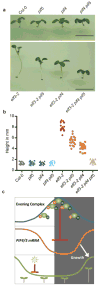The ELF4-ELF3-LUX complex links the circadian clock to diurnal control of hypocotyl growth
- PMID: 21753751
- PMCID: PMC3155984
- DOI: 10.1038/nature10182
The ELF4-ELF3-LUX complex links the circadian clock to diurnal control of hypocotyl growth
Abstract
The circadian clock is required for adaptive responses to daily and seasonal changes in environmental conditions. Light and the circadian clock interact to consolidate the phase of hypocotyl cell elongation to peak at dawn under diurnal cycles in Arabidopsis thaliana. Here we identify a protein complex (called the evening complex)--composed of the proteins encoded by EARLY FLOWERING 3 (ELF3), ELF4 and the transcription-factor-encoding gene LUX ARRHYTHMO (LUX; also known as PHYTOCLOCK 1)--that directly regulates plant growth. ELF3 is both necessary and sufficient to form a complex between ELF4 and LUX, and the complex is diurnally regulated, peaking at dusk. ELF3, ELF4 and LUX are required for the proper expression of the growth-promoting transcription factors encoded by PHYTOCHROME INTERACTING FACTOR 4 (PIF4) and PIF5 (also known as PHYTOCHROME INTERACTING FACTOR 3-LIKE 6) under diurnal conditions. LUX targets the complex to the promoters of PIF4 and PIF5 in vivo. Mutations in PIF4 and/or PIF5 are epistatic to the loss of the ELF4-ELF3-LUX complex, suggesting that regulation of PIF4 and PIF5 is a crucial function of the complex. Therefore, the evening complex underlies the molecular basis for circadian gating of hypocotyl growth in the early evening.
Figures




References
-
- Wijnen H, Young MW. Interplay of circadian clocks and metabolic rhythms. Annu Rev Genet. 2006;40:409–48. - PubMed
-
- Yakir E, Hilman D, Harir Y, Green RM. Regulation of output from the plant circadian clock. FEBS J. 2007;274:335–45. - PubMed
-
- Harmer SL. The circadian system in higher plants. Annual review of plant biology. 2009;60:357–77. - PubMed
-
- Nozue K, et al. Rhythmic growth explained by coincidence between internal and external cues. Nature. 2007;448:358–61. - PubMed
Publication types
MeSH terms
Substances
Grants and funding
- F32 GM083585/GM/NIGMS NIH HHS/United States
- R01 GM056006/GM/NIGMS NIH HHS/United States
- R37 GM067837/GM/NIGMS NIH HHS/United States
- GM67837/GM/NIGMS NIH HHS/United States
- R01 GM50006/GM/NIGMS NIH HHS/United States
- RC2 GM092412/GM/NIGMS NIH HHS/United States
- R01 GM079712/GM/NIGMS NIH HHS/United States
- GM080930/GM/NIGMS NIH HHS/United States
- R01GM79712/GM/NIGMS NIH HHS/United States
- R01 GM050006/GM/NIGMS NIH HHS/United States
- F32 GM080930/GM/NIGMS NIH HHS/United States
- R01 GM067837/GM/NIGMS NIH HHS/United States
- GM083585/GM/NIGMS NIH HHS/United States
LinkOut - more resources
Full Text Sources
Other Literature Sources
Molecular Biology Databases

